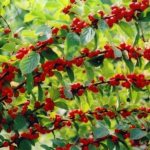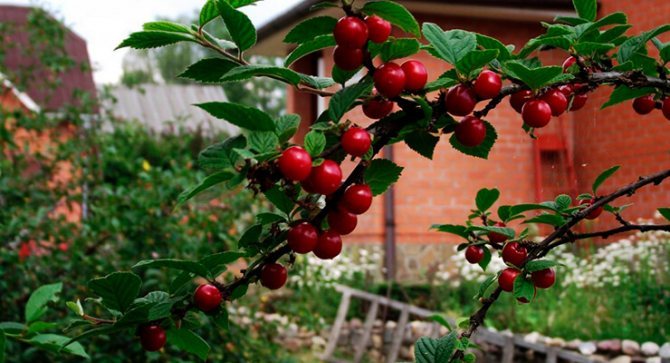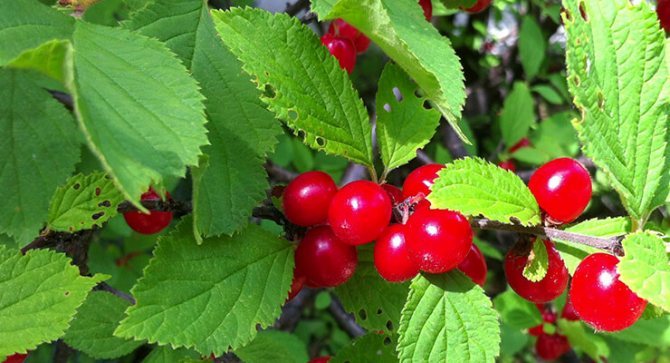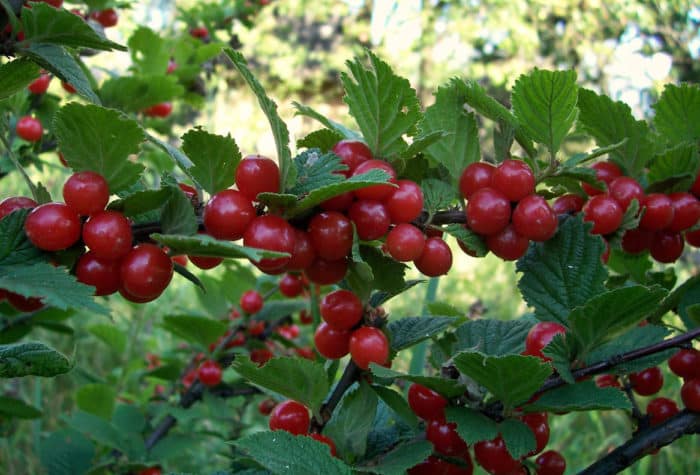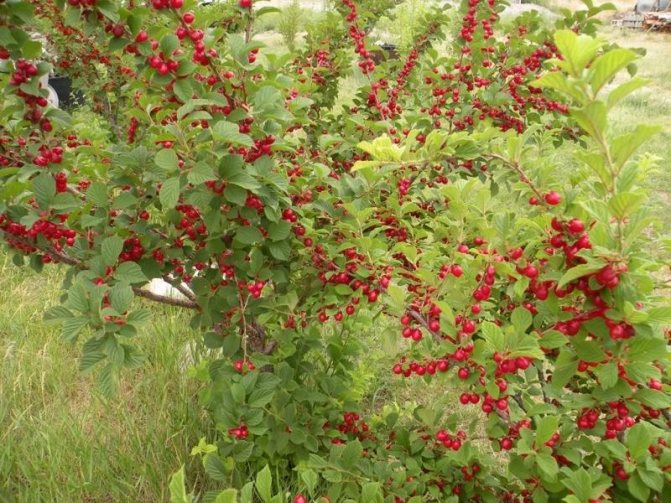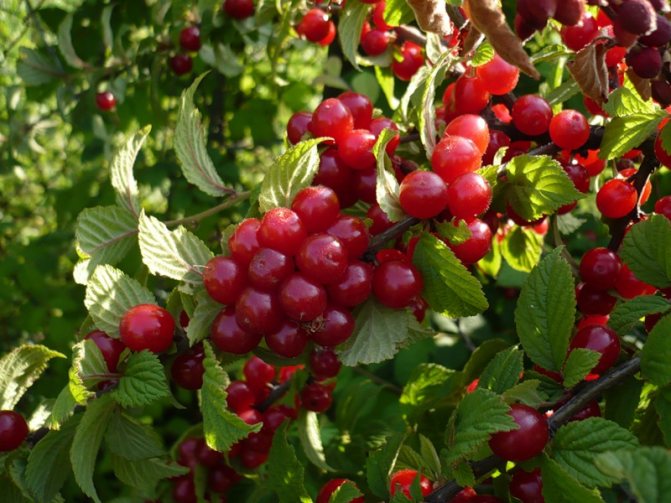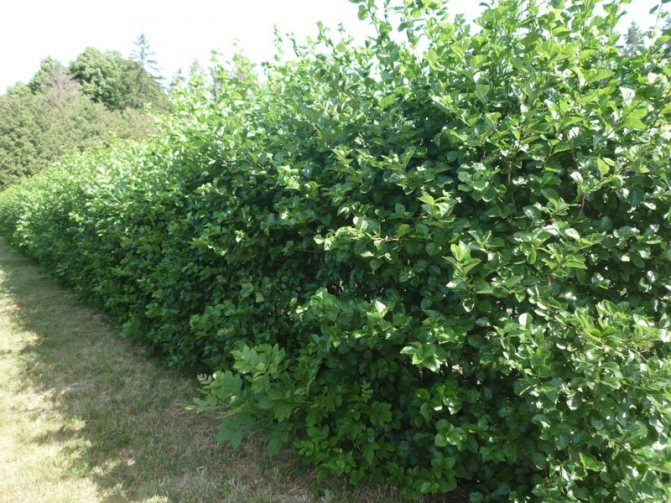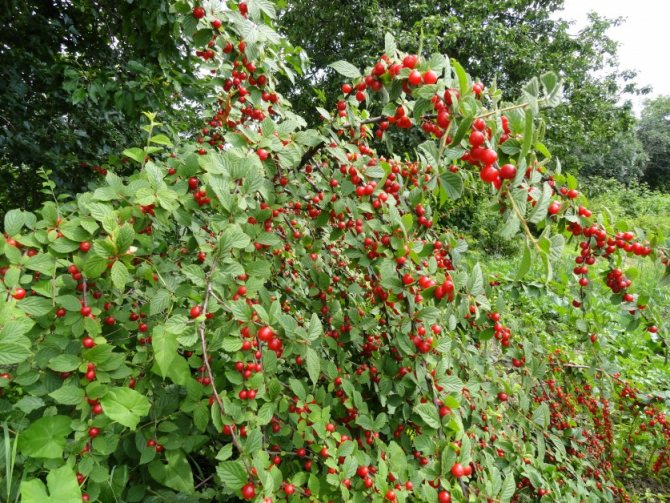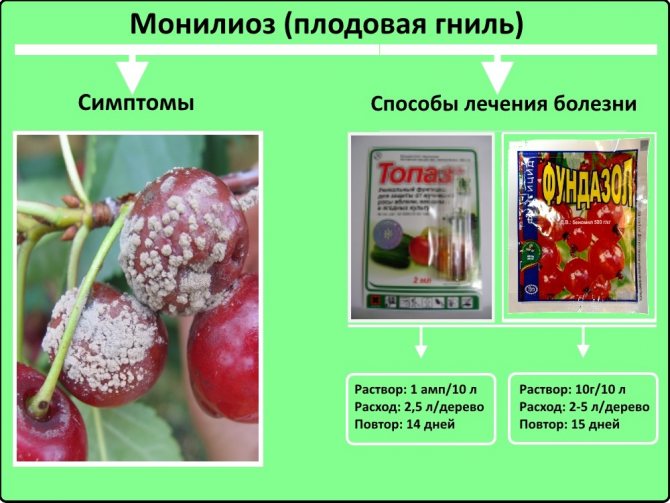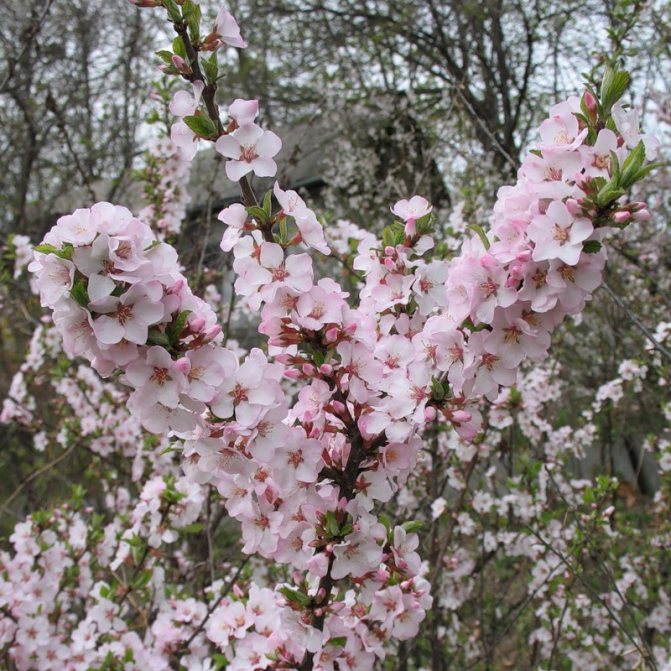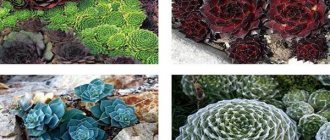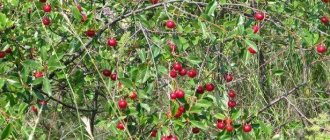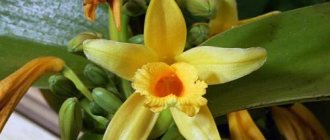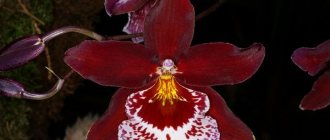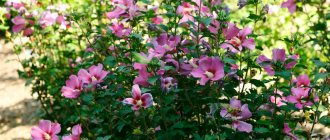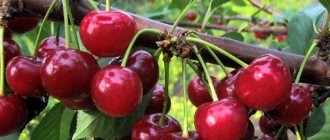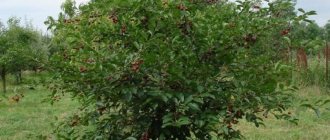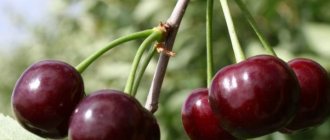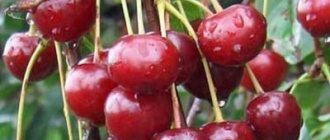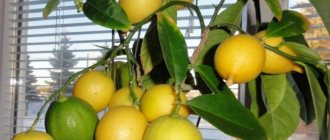According to the scientific classification, the Felt cherry (Prunus tomentosa) belongs to the genus Plum, it is a close relative of all representatives of the subgenus Cherries, peaches and apricots. The homeland of the plant is China, Mongolia, Korea. In southern Kyrgyzstan, there is also a wild-growing felt cherry shie or chiya, as the locals call it.
The plant came to the territory of Russia at the end of the 19th century from Manchuria, took root in the Far East, and from there moved to other cold regions of the country, the European part, Belarus and Ukraine. Of the breeders, Michurin was the first to pay attention to the Chinese felt cherry. He became interested in her unprecedented frost resistance and fruiting stability. This made the species stand out from other cherries and allowed it to be cultivated in harsh climates.
Felt cherry: description
The culture got its name for the characteristic fluff of small villi that covers the leaves, annual shoots, pedicels and even the fruits themselves. Fruiting of the felt cherry begins at the end of June and lasts about a month. For better pollination, it is recommended to plant several varieties of felt cherries side by side.
The plant itself cannot be called a tree - it is rather a shrub with several powerful skeletal branches and a rounded crown of strong thickening. Its height rarely exceeds 2 m, and lignified branches are covered with rough gray-brown thick bark. Felt cherry flower buds are located on annual and perennial shoots, 3 together on a short peduncle, so it seems that the fruits grow directly on the branches.
Features of the variety
This cherry variety belongs to plum crops. Since the cultivation of the variety, felt cherries have learned to cross with such trees as: peach, apricot, plum and cherry plum.
The variety has many advantages: resistance to sudden changes in temperature, beautiful appearance, the ability to consistently give high yields, etc. If all planting and maintenance rules are followed, the yield of this cherry variety can reach up to 4 kg per tree.
Positive qualities of the variety
In addition, felt cherry has the following features:
- the variety is characterized by tasty, juicy fruits, the taste is sweet, but there is a hint of sourness;
- cherries are rich in useful trace elements, vitamins B, C, PP, polysaccharides and others;
- after planting the tree, the fruits appear in two years;
- the fruiting period lasts from the second half of June to the end of August;
- cherry variety is unpretentious to growing conditions;
- the tree easily tolerates high frosts, drought and erosion;
- the tree is resistant to many diseases;
- root growth is not typical for the variety.
disadvantages
The fruits of this variety cannot be stored for a long time, therefore they are unsuitable for long-term transportation. The average lifespan of a cherry is 10 years, then the tree stops bearing fruit and dries up.
Periodic pruning is required, since without it the bush grows strongly. This helps the plant to live almost 10 years longer.
Felt cherries are immune to many common plant diseases, but are susceptible to moniliosis - fruit rot. An important condition for a tree to bear fruit is the presence of other varieties in the neighborhood.
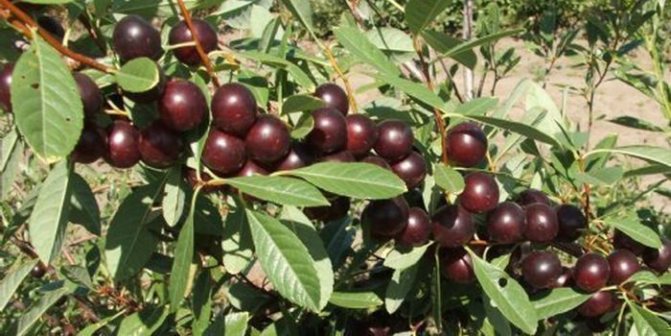
Big benefits of a small berry
Felt cherries contain a lot of nutrients and minerals. There are rare ones - rubidium, boron, vanadium. Scarlet berries have a beneficial effect on the body with regular use. They are useful for the heart and blood vessels, because they reduce the content of harmful cholesterol, increase the lumen of blood vessels, allow the use of fewer drugs - statins, are excellent prevention of heart attack, atherosclerosis, stroke.
Also felt berries:
- fight vitamin deficiency;
- help the liver to get rid of excess fat;
- increase metabolism;
- help the blood to cleanse itself of toxins;
- increase intestinal peristalsis;
- provide prevention of hemorrhoids;
- prevent the formation of intestinal cysts;
- increase resistance to stress;
- help to overcome insomnia;
- increase the chances of conception in women;
- prevent the development of prostate adenoma in men;
- help to rejuvenate the body;
- help people with diabetes mellitus in the assimilation of food.
Light acidity increases appetite. Berries are recommended for children to improve the digestion of food and increase the production of gastric juice. These are natural vitamins that are completely absorbed by the body.
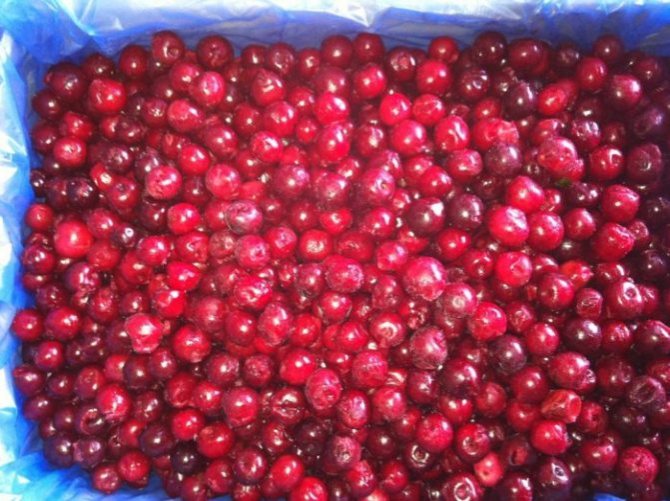

Felt cherry: care and cultivation, pruning, photo during fruiting
Caring for a felt cherry is reduced to its sanitary and thinning pruning, protection from diseases. And, of course, I drain the accumulation of water, if they suddenly began to appear at the landing site. Special feeding is not needed, all the nutrients will be provided by mulch or sod. Only foliar dressing is possible at the time of general processing of the garden with tank mixtures.
Felt Cherry Pruning
Plants develop quickly enough after planting and tend to thicken. Therefore, the following scheme for trimming the felt cherry is used: the leader is cut out, and as it grows, 5-6 strong branches are left, and the weak branches are removed to the ring. Be sure to trim the central part by cutting, lightening the center. In the southern regions, pruning is possible in the fall after leaf fall, and in the northern regions it is better to do this in the spring and after harvest (in July).
Sick, broken and thickening branches are cut to a living bud. After 5 years, rejuvenation is done - old and weakened branches are cut off, instead leaving the same amount from the stem (if a stem is formed) or from the base of the bush (if the free form is preserved).
Felt cherry diseases
It used to be that felt cherries were less susceptible to disease than other stone fruits. But moliniosis did not regret it either - during flowering and the appearance of the first ovaries, the flowers turn brown, then the twigs turn black, the plant is strongly oppressed. To prevent the development of the fungus, during the pink cone period, it is necessary to process the planting with a tank mixture with Fitolavin. If spraying is not carried out on time, monitor the infected shoots, cutting them below the first healthy bud. In summer and autumn, the treatment is repeated. Felt cherry is relatively resistant to klyasternosporiosis, therefore, preventive biological dressings (again with tank mixtures) that increase immunity are quite enough.
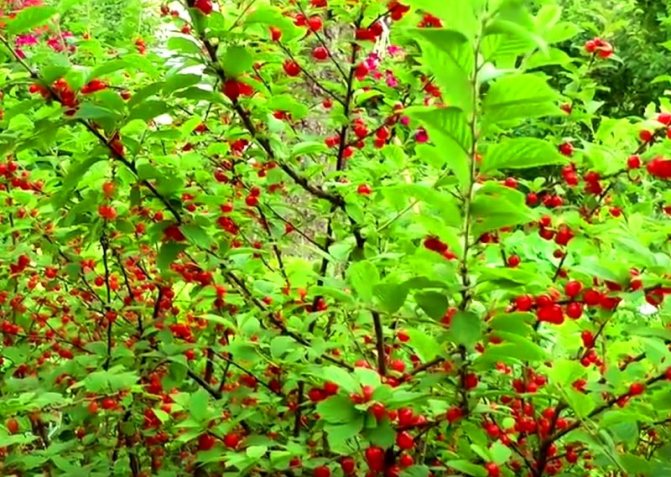

Array
Landing rules
Felt cherries are planted in spring or early fall. You need to be in time before bud break. To get a good harvest, you need to plant at least 3 bushes nearby. This will help self-pollination. Cherry propagation occurs by seedlings that have reached the age of 1-2 years.
Soil preparation
For felt cherries, the best soil is loamy, sandy loam, fertile soil with good drainage. The root system of the bushes is sensitive to excess moisture, so when planting it should not be deeply buried. This will contribute to the formation of diaper rash of the root neck. It must be above the soil level so that the plant does not die. To plant cherries, you need to dig a hole half a meter deep, 70 cm wide. Prepare the planting mixture separately.It should contain (per 1 meter2 of land):
- 30 g of potassium;
- 700 g of lime;
- 3 buckets of rotted manure;
- 50 g of phosphorus.
Pour the prepared mixture into the pit. Cut off the roots of the seedling, leaving only 20 cm. Dip in a clay solution to prevent diseases. Then immerse it in the prepared hole, leaving the root collar above the soil. Cover with soil, compact, water abundantly. Cover the place around the shrub with peat.
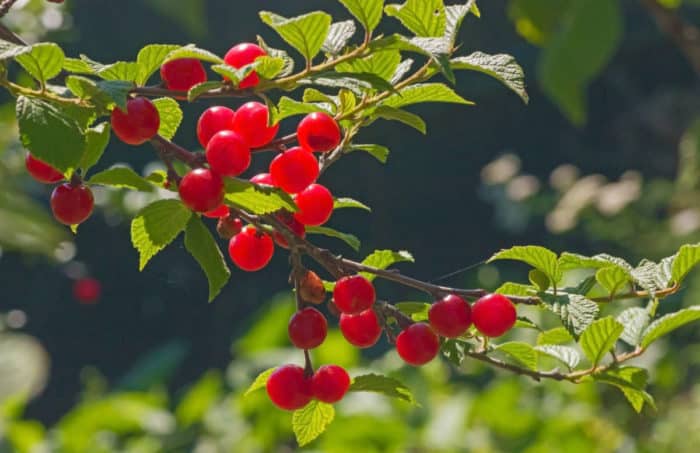

Main problems
The cultivation of the Chinese cherry comes with some difficulties. In recent years, she has suffered greatly from a monilial burn. In this destructive disease, the flowers and leaves first wither, then the branches begin to die off. If you do not remove the affected shoots, capturing 15-20 cm of healthy wood, the entire bush may disappear.
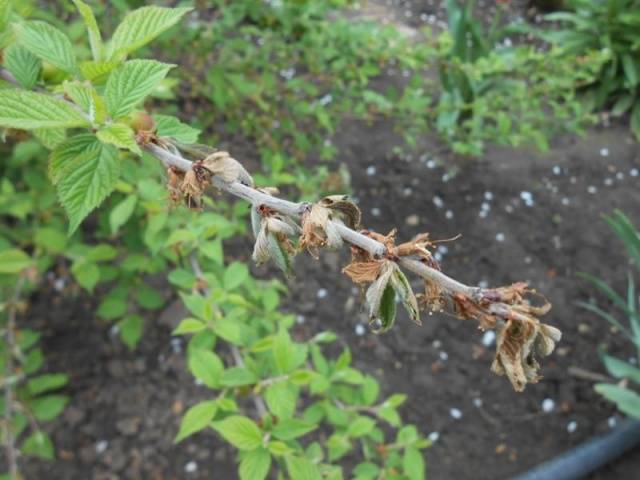

Where there is a high likelihood of return frost, medium and late varieties should be grown. The Chinese woman begins to bloom early, the buds can suffer not only from low temperatures, but also due to the absence of bees or bumblebees pollinating the plant.
Although felt cherry easily tolerates frost up to 40 degrees, in especially harsh winters, the cambium (part of the shoot between the wood and bark) and the core can freeze on old branches. They have to be cut out mercilessly, capturing a piece of healthy tissue.
The next problem is the drying out of the root collar, which happens from waterlogging of the soil in late summer or autumn, when the plantings are flooded when the snow melts. To avoid trouble, cherries are placed on hills or other areas where snow does not linger. If this cannot be done, not a tree that is rooted or grown from a stone is planted, but grafted on a stem that is resistant to soaking.
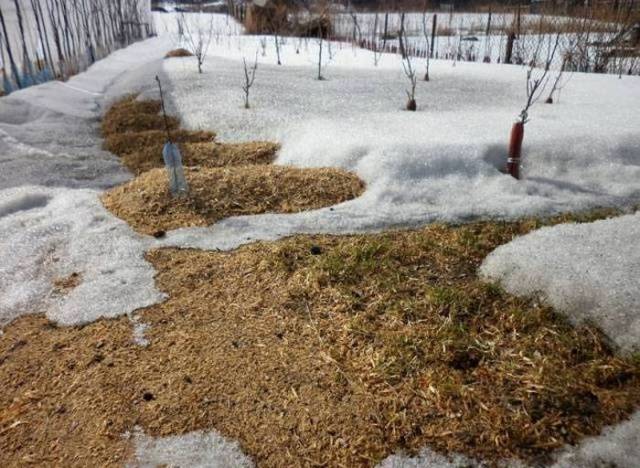

Propagation by cuttings
This is a rather unpretentious plant - Chinese cherry. Propagation by cuttings is used for the largest and most productive species.
Cuttings 15 cm long are cut from the shoots. They are treated with a growth regulator for 12 hours, tied into bundles. After this mandatory procedure, they can be planted. They are planted in pre-prepared pits. The stalk is deepened into the ground - 2 cm of a lignified stalk and one centimeter of green.
Then the seedling is covered with a film, its edges are covered with earth. So that the sun does not burn too much, the plant is covered with gauze in the daytime.
Array
Description of the variety
"Felt" or "Chinese" cherry is a real native of Asian countries - China, Mongolia and Korea, where it is represented in the wild. Culture began its path several centuries ago, but it was able to reach Russian territory only at the end of the 19th century. Local residents of the Far East associate cherry exclusively with "Felt", and for cultivation they mainly use an unvaccinated seedling.
The breeder Ivan Michurin was responsible for the breeding of the large-fruited form, who called this variety "Ando". Thanks to him, Kitayka entered European markets. If you pay attention to its appearance, you will notice significant pubescence of the shoots, leaves and the fruits themselves. It is this feature that determined the name "Felt".
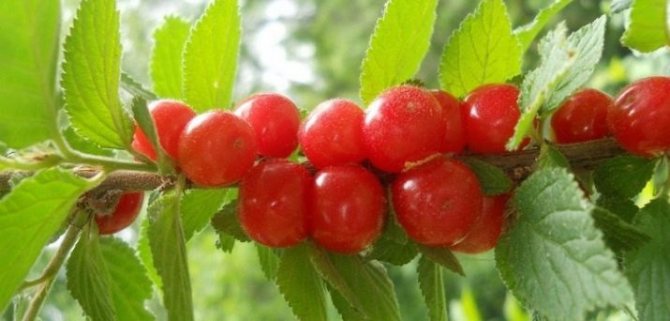

Cherry fruits have large reserves of carbohydrates, organic acids, vitamins and macronutrients. The advantage over the usual cherry variety is that the content of vitamin C is twice as much! The iron percentage is just as high, which is largely superior to that of apples.
The height of the tree reaches three meters, which is why the cherry is considered "Dwarf". The shape of the crown is a bit like an oval or even a ball. A feature is powerful shoots. The leaves are slightly wavy, small. The berries are small. Depending on the variety, the color of the berries is also determined: shades from light milky to maroon flowers. Sweet fruit with a slight sourness that does not spoil the taste.
During flowering, snow-white fragrant flowers with a honey aroma appear on compact cherry bushes. Such a beautiful bouquet naturally attracts bees.
In addition to taste and aesthetic qualities, bushes of red berries with spreading branches can act as a reinforcing material for a structure, for example, a fence, hedges, curbs.
A short life expectancy - a little less than 10 years - is the main disadvantage of the "Chinese" cherry, which gardeners and farmers were able to identify. But if you carry out such a rejuvenating procedure as pruning, you can extend the life of the tree up to 20 years.
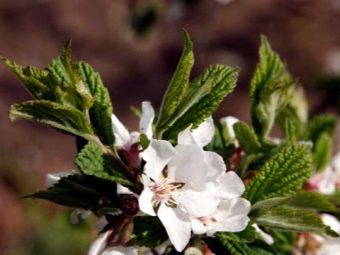

Advantages of the variety:
- easy to care for and harvest due to the small size of the tree;
- easy cultivation and reproduction;
- pleasant sweetness in the taste;
- decorative appearance of the bush;
- early fertility;
- stable yields;
- the berry does not crumble;
- not afraid of the disease of coccomycosis;
- early ripening of fruits;
- drought resistant.
Disadvantages:
- a high level of susceptibility to the disease moniliosis;
- short life span (10 years);
- some varieties are self-fertile (planting of a pollinator is necessary);
- the pulp and bone are poorly separated from each other;
- poor transportation;
- does not tolerate excess moisture.
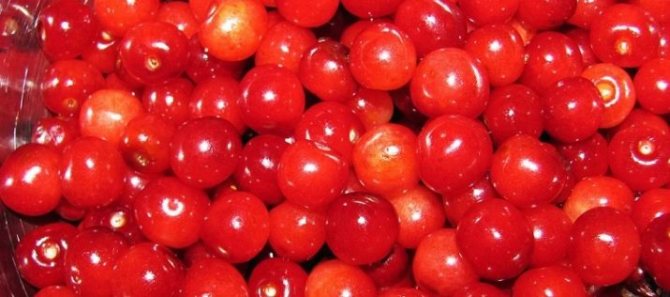

The best cultivars for the regions
The best varieties of felt cherries are presented in the State Register of the Russian Federation, but new ones appear every year, among which there are self-fertile, resistant to many diseases of stone fruit cultivars.
Felt cherry suitable for growing in Northwest Russia
Here, most often the berry bush suffers from recurrent frosts, therefore, summer residents pay special attention to the most resistant to low temperatures cultivars - Okeanskaya Virovskaya, Tsarevna, Natalie, Delight. The most dangerous in a damp climate is coccomycosis; as a result of breeding work, the Krasavitsa and Morning varieties have become popular here.
Varieties for Central Russia and the Volga region
The most unpretentious and worthy of the summer residents of the Chernozem region are the Osennyaya Virovskaya, Children's and Delight varieties. But the variety Natalie, Tsarevna and Alice can be considered no less profitable in terms of yield.
The Alice variety looks very impressive at the time of flowering, it is he who grows on our site. But in terms of fruiting, it is impossible to name the exact indicators of yield, year after year is not necessary. Often the fruits ripen on some shoots located closer to the hedge. Perhaps the buds freeze out, the bush grows in an open area near the road as a decorative element, therefore, we do not achieve maximum fertility. I really want to plant a white-fruited felt cherry, since this variety is spoken of as the most frost-hardy and picky. But we have not yet managed to find a zoned original in our Chernozem region, and seedlings from Siberia do not take root.
Reproduction
The breeding characteristics of felt cherries are the same as those of other fruit trees. There are three main methods of propagation: sowing seeds, cuttings and using cuttings.
Seeds
When harvesting, save a few cherry seeds for planting next year. Rinse them well and put them in a shady place to dry. Direct sunlight is not recommended.
In late summer, bury the seeds in wet sand and place the container in a cool place. In October, you can start sowing seeds in open ground. Dig shallow beds (up to 3 cm) and plant several seeds in each.
The seeds will sprout in the spring. If you take care of them correctly, the seedlings will grow very quickly and in one year they will be able to reach half a meter. A year later, in autumn or spring, the seedlings will need to be planted.
By cuttings
In order for the cuttings to grow, certain conditions must be created. Cuttings are recommended to be taken from branches that are at least 15 cm long, the second or third in the crown.
The grafting scheme is as follows: a one-centimeter green cutting of a given year is grafted onto a two-centimeter cutting of last year. Then the cuttings are planted on the beds, which must be insulated with a film.
In order for the cuttings to take root, it is necessary to constantly maintain warmth and humidity in the greenhouse. They must not be exposed to direct sunlight. If the greenhouse is in an open area, then shading may be required. Be sure to make sure that the cuttings do not dry out.
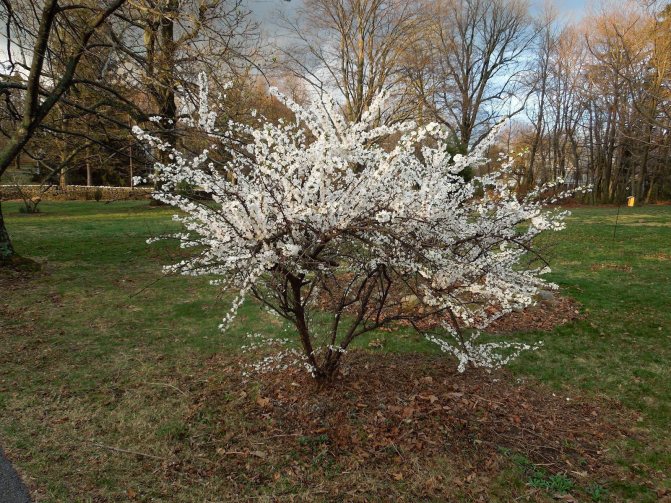

Felt cherry: pests and diseases
Most often, the shrub is affected by:
- Mice (or other rodents). For protection, they use strapping with spruce, juniper, raspberry, reed branches;
- Pocket tick. Do an insecticide treatment or spill it with hot water until bud break;
- Moniliosis or clotterosporiosis. The affected parts of the shrub are removed, treated with fungicides (Topaz, Horus) or a solution of copper oxychloride.
Felt cherry is an unpretentious compact shrub that, with proper care, can not only provide a tasty and healthy berry, but also become a worthy decoration of any garden or personal plot.
Diseases, pests
No matter how resistant the felt cherry is, a fungal infection can develop on it if care is not taken. You cannot be one hundred percent insured against harmful insects either.
Moniliosis
Most often, felt cherries are affected by the monilia fungus. A monilial burn can be recognized by a number of signs:
- dried, as if burnt or frozen leaves and branches;
- flowers and leaves turn brown and then wither;
- a grayish bloom appears on the berries, they become brown, and the taste of the pulp acquires a shade of alcohol;
- the berries are mummified and in this form can both fall and remain hanging on the branches without falling;
- small whitish seals form on the petioles;
- gum flow begins.
The causative agent of the disease is the fungus Monilia cinerea. Spores are carried by wind and insect pests, and penetrate the plant through damaged bark. They overwinter in fallen leaves and fruits. The active development of the fungus occurs at an air temperature of +15 ° C to +20 ° C and humidity close to one hundred percent.
To prevent the disease, the diseased parts of the cherry tree are removed and destroyed. As well as fallen leaves. It is imperative to weed out the weeds under the bushes and avoid excessive moisture in the berry. Before wintering, the trunks are whitewashed with lime, the cherries are sprayed with fungicides, and the soil is dug up in the near-trunk circle. This measure will also help against pests.
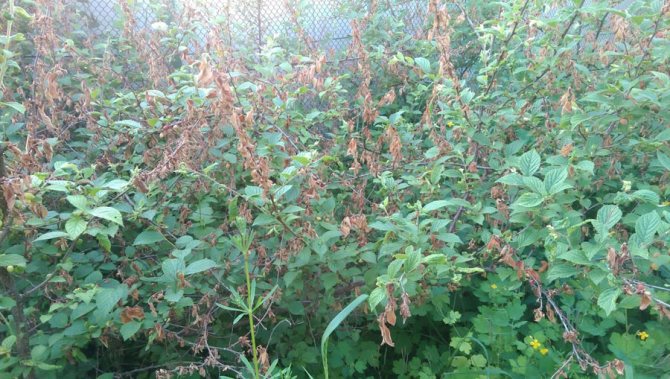

Moniliosis is one of the most dangerous diseases of the felt cherry
Clasterosporium disease
Much less often moniliosis, felt cherry can get clotterosporiosis, to which most varieties have medium resistance. In another way, this disease is also called perforated spot, except for cherries, cherries, plums, peaches, apricots can get sick.
Advertisement 2
The cause is the fungus Clasterosporium carpohilum. You can recognize the presence of an infection in felt cherries by the following signs:
- the appearance on the leaves of round light brown spots with a crimson edging;
- over time, holes form in place of the spots;
- leaves dry up, fly around;
- reddish spots appear on shoots and buds;
- isolation of gum;
- falling off of the affected shoots;
- purple sores appear on the berries;
- fruits may dry out on one side.
Severe damage to branches and shoots can lead to the death of cherries. As with any other fungal infection, with clasterosporium disease, it is necessary to get rid of the infected parts of the plant, they need to be burned. Crown, stem, as well as the trunk circle are treated with fungicidal preparations. To prevent the disease, they do not allow waterlogging in the berry, prevent the growth of weeds, remove the carrion on time, and fight insect pests.
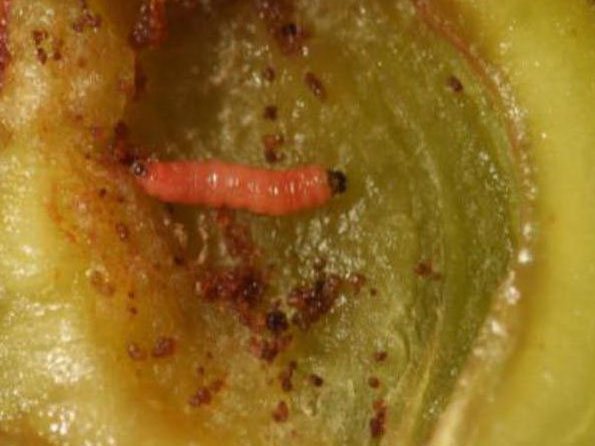

Of the harmful insects on the felt cherry, there are plum moth, aphid, leafworm
Plum moth
The plum moth causes great harm, eating the flesh of stone fruit crops. The pest is ubiquitous. The adult is a brown butterfly with a wingspan of 1.2-1.5 cm, the lower wings are noticeably lighter than the upper ones, there is a fringe along the edges.
Plum moth caterpillar
Butterflies fly in the middle of summer. They live no more than two weeks, during which time they manage to lay eggs on the berries or the underside of the leaf plate. The hatched caterpillars are first off-white and then reddish in color, feed on the pulp of the fruit, and can also damage the bone in unformed berries. The cherry stops developing and falls off. Caterpillars hibernate, wrapped in a cocoon of cobwebs in the bark or in the upper layers of the soil, on plant debris. In the spring, as soon as the air warms up to + 10 ° C, the overwintered larvae pupate. In June-July, the next generation of butterflies flies out.
To combat the plum moth, the following measures are taken:
- after flowering, the berry is treated with insecticides such as Fitoverm, Iskra Bio;
- during the ovary of berries, re-processing is carried out;
- when the cherry blossoms, trapping belts made of sticky material are placed on the trunks;
- damaged and fallen berries are regularly removed;
- digging up the soil under the trees;
- remove plant residues.
You can use such an environmentally friendly method as attracting natural enemies of the moth - birds to the garden.
Advertisement 3
Aphid
Another pest that can be found on felt cherries is aphids. Often it grows in those gardens where there are many anthills. Aphids pierce tender young leaves with their proboscis and feed on intercellular sap, weakening the plant. To get rid of aphids, leaves with insect colonies are cut off and burned. The bushes are treated with infusions and decoctions of herbs according to folk recipes. A soap-and-water solution has also proven itself well. It is prepared by mixing a glass of ash with one piece of laundry soap diluted in water. If there are too many aphids, you can resort to industrial insecticides such as Iskra, Admiral, Commander. But it is better to use them only in the most advanced cases.
Caring for felt cherries is easy, this is also one of the reasons for its popularity among summer residents.
Gardeners reviews
Helga
Felt cherry is self-fertile. For harvests, either "neighbor" explosives are needed, or the purchase of different varieties.
Astroved
There are also varieties that are not susceptible to moniliosis, the best and most delicious variety is Damanka, but the real Damanka is a rarity, almost everything that is sold under this name is Damanka seedlings, with a partial loss of varietal characteristics and quality.
Testimonials
Felt cherries are much less popular with gardeners than ordinary cherries, but many plant at least two or three bushes for food. The main plus is its early ripening and you can enjoy the berries while the usual cherry is not yet ripe.
Natalya, Leningrad Region We have felt cherry Ogonyok, it grows well, I process berries, compotes, jam. It is very tasty when fresh, especially children like it.
Valery, Moscow region The main thing is not to pour the felt cherry, otherwise moniliosis is guaranteed.
Tatiana, Voronezh She planted a Chinese cherry, blossomed profusely, the view was gorgeous, but there were no berries. She definitely needs pollinators. I planted a couple more felt ones and the harvest was not long in coming!
Pronounced healing properties of the plant
Like other horticultural crops, felt cherries are a real treasure trove of nutrients. Its berries contain vitamin C, linoleic acid, which is effective for weight loss and multiple sclerosis, as well as natural polysaccharides that provide the body with energy. In addition, if you eat fresh berries regularly, you will have:
- blood pressure stabilizes;
- the work of the heart, blood vessels, stomach and intestines will improve;
- insomnia will disappear;
- relieve the condition with gout and arthritis;
- the cold will pass faster;
- the activity of inflammatory processes will decrease;
- animal fats and proteins will begin to be better absorbed.
Felt cherries help fight aging. it contains antioxidants that neutralize free radicals.
Care after landing
After the cherry blossoms, it is necessary to fertilize with mineral nitrogen-containing fertilizers. These fertilizers should be applied along the border of the trunk circle.
Do not forget that the soil needs to be loosened regularly. It should be carried out carefully and shallowly so as not to damage the root system of the seedling. The optimum loosening depth is not more than 4 cm. In autumn, exclude fertilizing with nitrogen-containing fertilizers. Otherwise, the plant will release young shoots, which will die during the first frost, and with them the tree may wither.
Watering should be rational. Do not overmoisten the soil, this will adversely affect the growth, fruiting and preparation of the shrub for the winter period.
You should also pay attention to the formation of the correct shape of the bush. To do this, cut the seedling at a height of 40 cm. In the second year, all side branches are cut by a third. The crown of the tree needs constant monitoring. It should not be allowed to thicken, which stimulates the development of fungal diseases.
Prune the branches annually to promote regular growth and abundant fruiting. Perform this procedure in the first month of spring. When pruning branches, remove diseased, deformed and old branches first. To thin out the crown, keep no more than 10 strong and healthy shoots, the rest will have to be cut off.
Always remember that if you want to grow a healthy tree, get high and high-quality yields of felt cherries, planting and caring for them must be carried out regularly and correctly. Prune the tree in time, prevent the appearance and development of diseases.
disadvantages
Felt cherry may seem like the perfect plant, but it also has quite a few drawbacks. Some of them are easy to overcome, while the rest can become a serious obstacle to the cultivation of this berry bush.
- Low life expectancy. Felt cherries rarely live up to 15 years. On average, her life span is 10 years. Pruning regularly will help extend it just as much. But even this rarely saves the bush from death, so lovers of felt berries have to constantly grow new bushes to replace the aging ones.
- The need for regular pruning. Pruning is needed not only to extend the life of the bush, but also to make it decorative. However, this is not such a drawback, because many country plants need pruning. But in general, you have to work a little. The crown of cherries often thickens, so it needs to be thinned out, and the shoots should be cut off by a third. The procedure should be carried out every 3-4 years, otherwise the harvest will not be so much.
- Frequent heating of the bark during thaws. Felt cherries are frost-resistant, but thaws cause irreparable harm to them. When it gets a little warmer, the bush wakes up. But if it snows again, plant tissues begin to suffocate from lack of oxygen. As a result, the bark peels off, most often in the zone of the root collar, and the aerial part of the bush dies. To prevent this from happening. the snow must be urgently removed, but, alas, it is not always possible to do it on time.
- Self-infertility. Felt cherries need cross-pollination, so you need to plant at least 2-3 bushes nearby. The bush is not pollinated by other types of stone fruit.
- Very delicate berries. In markets and shops, you are unlikely to find felt cherries, because they are not suitable for long-term transportation and storage. You have to eat or process them right away.
- The tendency to get sick with moniliosis.Unfortunately, this ailment often affects felt cherries and deprives summer residents of their harvest. First, it manifests itself on berries, and then goes on to leaves and shoots. To reduce the danger, you need to regularly inspect the bushes and remove the affected parts.
Care
The Chinese cherry is a crop in which the flowers are not pollinated by their own pollen. Because of this, several varieties are placed nearby for high yields.
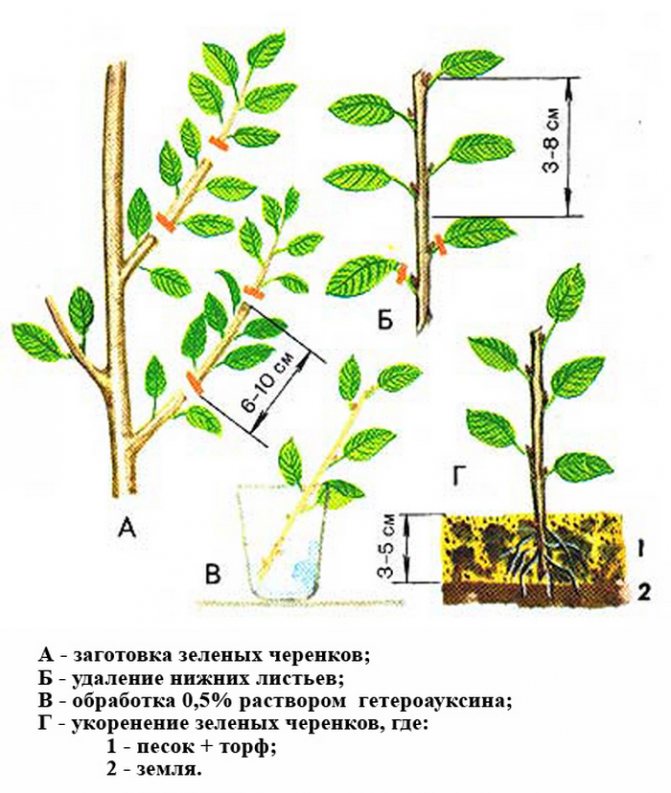

Chinese Cherry Care
Cherry Nadezhda
The optimal planting time is the beginning of spring, when the buds have not yet had time to bloom. The procedure can be carried out in the fall, but not later than September. Seedlings purchased later are stored until spring.
Additional Information! The central branches are thinned out every year, leaving 10-12 of the best shoots.
Chinese cherries bring many healthy berries. They appear already in the 3rd year of growth. If properly planted and well looked after shrubs, up to 4 kg of fruit can be harvested from one plant. They ripen at almost the same time. There is a lot of juice in the berries, they have a pronounced aroma and sweetness. The colors can be different - from pale pink to deep red. The specific shade depends on the variety.
Fresh berries cannot be stored and transported for a long time. Because of this, they are not sold in stores. For transportation, you should pick unripe fruits when they grow to their maximum size and almost completely pick up color.
The need for pruning
Early fruiting, short growth and spreading of the crown lead to a rapid drying out of the trunk. Pruning dwarf felted cherries correctly in the fall will improve crop quality and longevity. It is necessary to carry out molding, sanitary renewal of the crown to obtain large berries, remove diseased and insect-affected branches. The aim of the activities is full pruning:
- branches from the lateral parts, deepened into the crown;
- shoots that are weakened or withered after fruiting;
- old branches, which do not give growth of branches, do not bear fruit;
- overabundance of branches to maintain the quality and quantity of berries.
Culture is not only cut in the fall. Spring and summer shoot removal is allowed.
Reproduction by layering
To get a "clone" of the mother tree, gardeners often use horizontal layering. In early spring, all but one stem is cut from the Chinese cherry bush. In one year, strong new stems will appear in such a bush. Next year, they should be laid in a groove up to 15 cm deep and pinned. Vertical shoots will grow from them, which must be constantly sprinkled with fresh earth.
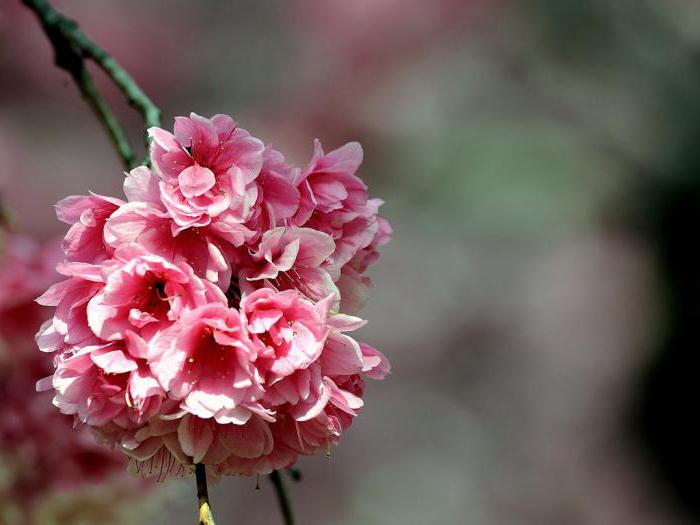

Good taste of fruits
Felt cherry fruits are tender and juicy in taste, with a slight sourness. A bit like an ordinary cherry. Berries are used to prepare aromatic wines and liqueurs, sweet juices, syrups and fruit drinks. Felt cherry blanks are very popular: preserves, jams, compotes. Some cooks successfully make marmalade from berries. And fans of canned vegetables add cherry leaves to pickles and marinades.
In central Russia, felt cherry blossoms about a week earlier than usual, and its berries also ripen faster. Usually, already at the end of June, you can enjoy the first harvest. Remarkably, ripe berries do not fall off and can remain on the bushes for a long time, right up to spring. Of course, they will no longer be ripe, but dry up. But on the other hand, there is no need to immediately rush to harvest, in fear that the berries will fall off.
As for fruiting, everything is fine here too. From one adult bush, you can collect up to 10 kg of berries, from a young one - 2-3 kg. There are usually so many berries that the branches of the bush bend under their weight.
Felt cherry is fast-growing. Saplings and grafted cuttings can yield a harvest in the second year, and plants grown from seeds - for 3-4 years.
Meet the cherry from China
The popular shrub gets its name from its place of origin. Homeland is China, Mongolia and Korea.There cherry (sakura) grows everywhere, is a symbol of love. In central Russia, such a cherry is often called felt. The term originated from the delicate feathers that cover the underside of leaves, berries, pedicels. It looks like soft felt. The photo shows a cherry 5 years old. About 10 kg of berries are harvested from it. Felt cherry is a shrub almost 3 meters high. The leaves are special - corrugated, in the form of an oval with a sharp end. The flowers reach a diameter of up to 2.5 cm. The fruits are scarlet, because of this color, the shrub can be called cherry. The berries have a short stalk, which is why they literally stick around the branch and do not crumble when ripe. Their taste is sweet with a slight sourness, like cherries. Inside there is a small bone that is difficult to separate. The photo shows how the branch is strewn with ripe berries.
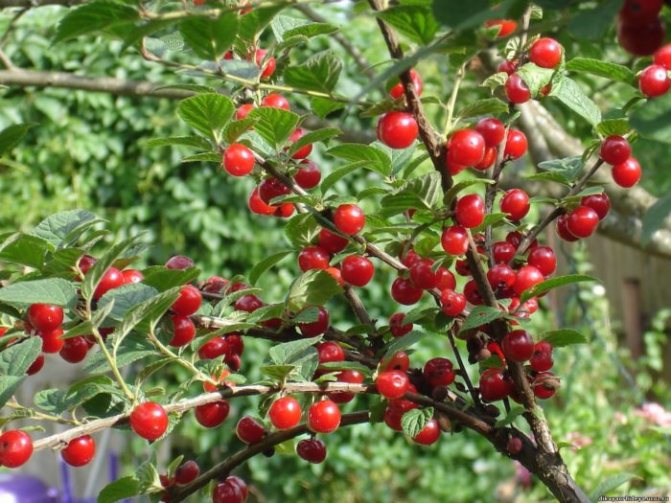

Growing conditions
Felt cherry is very undemanding to growing conditions. Thanks to these qualities, it has found mass distribution in suburban and suburban areas in every corner of Russia. For its timely development and good fruiting, it is necessary to adhere to the minimum agrotechnical requirements:
- choose a suitable landing site;
- ensure timely watering and fertilization;
- organize a mulching layer in the trunk circle;
- perform timely pruning;
- protect from winter cold.
These simple steps will allow you to grow a fragrant felt cherry in your own garden and enjoy the incredible taste of its berries.
Optimal location and lighting
The most suitable place for planting is a sunny, open area of the cottage. The bush does not tolerate shading well, therefore, when planning a garden, it is placed as far as possible from tall trees. The plant does not take root well in lowlands and pits, where excess moisture accumulates. In such conditions, the root system does not develop well and decays over time.
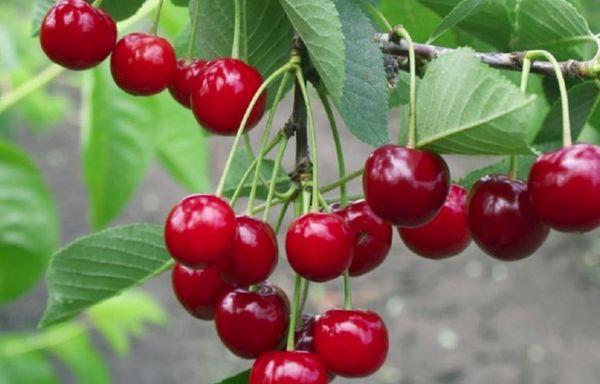

Soil composition
Felt cherries need fertile soil. The close location of groundwater will hinder the timely development of a young seedling. Neutral loams and sandy soils are ideal for growing this shrub.
Favorable and unwanted neighbors
Felt cherry requires favorable neighbors for active fruiting. Mutual pollination occurs perfectly between different varieties with the same flowering period.
The shrub gets along well with common cherries and sweet cherries. However, with such a landing, it requires enhanced preventive measures against moniliosis. Feels good with hawthorn, grapes and mountain ash. Planting the shrub away from tall trees will help avoid darkening and stunted growth.
Watering and feeding
Water the felt cherries carefully. She doesn't like stagnant water. With a lack of precipitation, the need for additional moisture arises during the growing season and the formation of berries. In order for air and water to penetrate to the roots, you need to loosen the soil next to the cherry. Excess moisture will lead to rotting of the root system, which will negatively affect the entire plant and the yield. For good development and fruiting, regular feeding is needed. The first time it is made immediately after flowering. Must be present:
Nitrogen is not needed in autumn feeding. It stimulates the emergence of new shoots, in cold weather they will die.
Things to Remember
- Sapling selection... An adult purchased seedling will begin to bear fruit in 1 - 2 years, grafted in about the same way, and when grafting or growing from a stone, it will take at least 5 years to wait for the harvest.
- Fruiting conditions... All felt varieties are self-fertile, i.e. they do not bear fruit alone, the bushes need a couple.
- Care... You cannot fill the tree. Nitrogen fertilizers are applied until June, then you need to switch to potash and complex fertilizers.
- Pruning... When planting, the seedling is pruned 20 - 40 cm from the ground, plus all new shoots are annually pruned to a quarter of the length.
Care features
For proper care of Chinese felt cherries, you need to know its weaknesses:
- rapid thickening of the crown;
- overheating of the root system;
- increased risk of contracting fungal diseases.
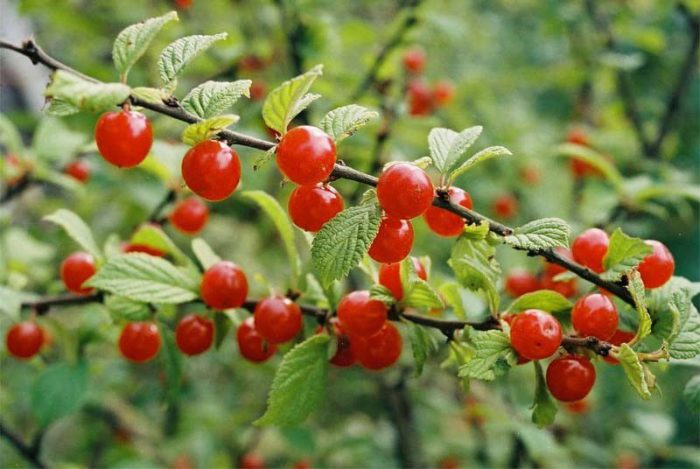

All these properties are taken into account when choosing a place, watering, pruning shrubs.
The basic rules of care are presented in the table.
| Name | Description |
| Watering | Held on dry days. It is constantly necessary to control the moisture content of the soil, avoiding strong moisture. |
| Top dressing | Cherries do not tolerate an increase in soil acidity. This leads to disruption of metabolic processes, a decrease in yield. If necessary, liming of the soil should be done every 5 years. |
| Diseases | In the fall, in the spring, it is necessary to carry out the prevention of diseases - to cultivate the land with fungicides, spray it with Bordeaux liquid. |
| Pests | For Chinese cherries, scale insects and aphids are dangerous. The risk of infection appears only if the entire garden area is affected. |
| Preparing for winter | Young seedlings should be tilted to the ground, insulated with spruce branches or straw. Mulch the trunk circle with peat. |
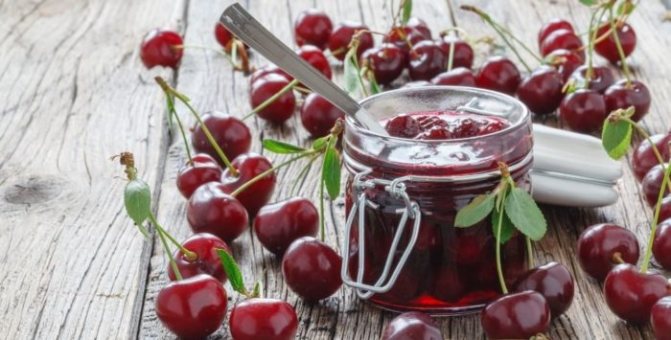

Felt cherry is called one of the most unpretentious shrubs. She does not require much attention, but responds with a large harvest.
Garden var
This is a special putty, which is used to treat damage on the bark or cut. You can buy putty at specialty stores, but it's easier to make your own.
Types of putty on:
- paraffin wax;
- wax;
- wood alcohol;
- lard.
Paraffin putty is prepared from a kilogram of paraffin, rosin and nigrol. The ingredients should be heated separately, and then the paraffin and rosin should be carefully poured into the nigrol. Wood ash can be added to the putty before use. Apply warm.
The recipe for wood alcohol putty includes rosin and lard (ghee). First, mix rosin (16 parts) with bacon (1), heat well. Then alcohol (8 parts) is added to the mixture, kneaded until a homogeneous consistency.
The cost of a beeswax varnish on the market is high. To create a putty, take 4 parts of wax, 20 linseed oil and 1 resin or rosin. When the mixture of wax and resin reaches a homogeneous consistency (it is heated), you need to add linseed oil. After boiling, crushed charcoal (2 parts) is poured over the var.
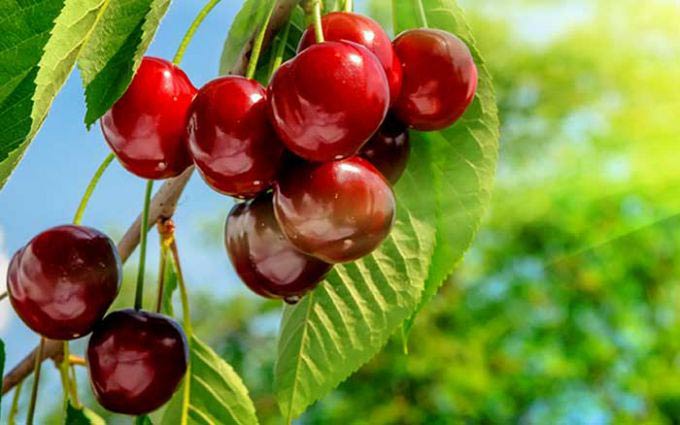

Agrarians recommend adding heteroauxin to the putty. One tablet is consumed per liter of vara. In cold regions, the cuts are treated with a protective compound against frost.
Putty on lard is prepared as follows. Softened wax is mixed into the melted bacon without greaves (lard) and the mixture is brought to a homogeneous state. The proportions of fat and wax are 2: 1. Then add crushed rosin (4 parts) and bring to a boiling state. Keep on fire for half an hour, then poured into cold water. Knead the mixture in water.
At what time of the year can you cover trees with garden pitch? There are no restrictions on the use of putty, it is used as needed.
Things to consider when boarding
Before purchasing planting material, you should decide on a place for growing. It is categorically impossible to plant this crop in lowlands, wet, wetlands, near water bodies, as well as where groundwater is located close to the surface.
Besides:
- the site should be well lit by the sun;
- be protected from strong gusts of wind;
- from soils, sandstone and loam are preferred.
After the place for the felt cherry is determined, they begin to select the seedlings. A varietal seedling must be purchased at the nursery. It should be healthy in appearance, with light, well-developed roots, free of any signs of diseases or pests.
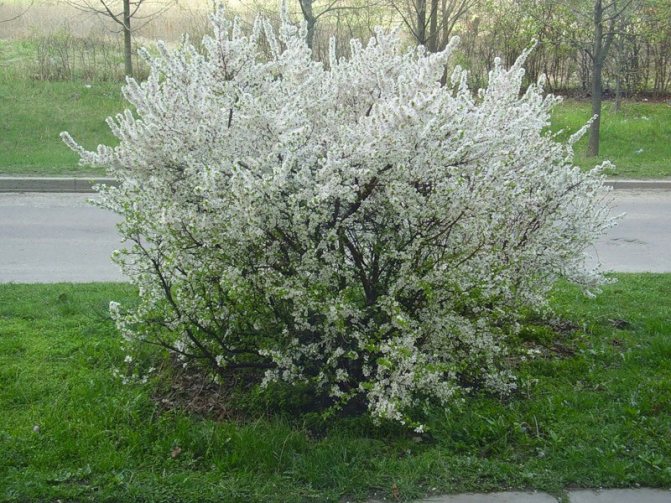

During flowering, the felt cherry bush looks like a large beautiful bouquet
When planting felt cherries, they act according to the following algorithm:
- Dig a hole with parameters 50 × 60 cm.
- Drainage from gravel or expanded clay is placed at the bottom, pebbles, broken brick are also suitable.
- Humus or compost, 0.5 kg of lime, 25 g of potassium nitrate and 50 g of superphosphate are poured next. This mixture must be mixed thoroughly.
- A seedling is placed in the hole, pre-cutting the roots by about 25 cm and dipping them into a growth stimulator solution.
- The hole is covered with soil, tamped a little and watered. When watering, the water should not be cold!
- Tie the seedling to a support previously installed in the pit;
- The root zone is mulched with ash, sawdust, peat or straw.
Planting is best done in spring, so the tree will have time to get stronger and be able to endure the winter well. If an autumn landing is planned, it is correct to carry it out no later than the end of September. Since the Chinese cherry is not self-fertile, it is recommended to plant 3-4 varieties at once at a distance of 2-3 meters from each other. But if cherry plum, apricot or plum grows on the site, cross-pollination of felt cherry can also occur with these crops. But ordinary cherry is not suitable as a pollinator.
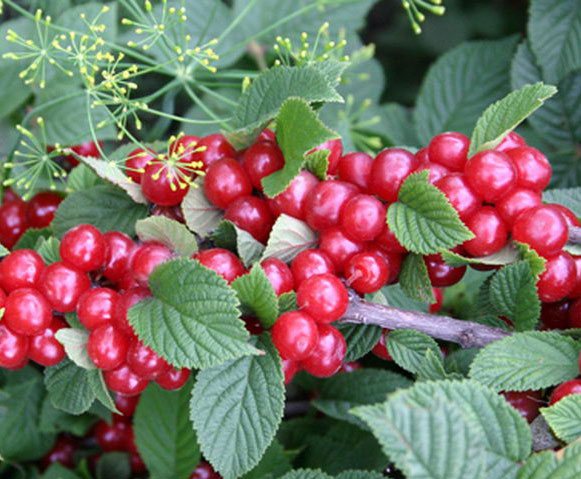

Felt cherry berries are close together
High decorativeness of bushes
Felt cherry can be propagated in several ways:
- grafting (can be grafted onto a regular cherry);
- sowing seeds (this way you can propagate cherries, but not the variety);
- green or lignified cuttings (cuttings are the best way to propagate fruitful cherries);
- layering (the lower branches are laid in grooves and looked after during the season).
Felt cherry bushes look beautiful all season. In May, they are densely covered with white or pink flowers. And by the end of June and early July, garlands of red or burgundy berries are visible on the branches. The fruit stalks of the berries are very short, close to the branches, like sea buckthorn. Therefore, outwardly, the plant looks very unusual and attractive.
Even after harvesting, the bush does not lose its decorative effect. And if the harvest is not harvested in the summer, the felt cherry in the fall and winter will be covered with dried berries that will not fall off until spring.
Felt cherry is often used in landscape design, putting its decorativeness in the first place. Plant a few bushes near the fence - and you will immediately notice that the site will be transformed! And healthy and tasty berries will be a nice bonus.
Variety characteristics
Kitayka is a felt cherry. Leaves of a pale green color on the back are covered with a grayish bloom. Sometimes this shade also appears on the trunk, which makes it look like felt.
This plant reaches quite impressive dimensions - up to 2 m in height. And if you create optimal conditions for development, this figure can rise to 3 m.
The berries of this culture are different from ordinary cherries. They have a lot of juice, and there is practically no acid in the taste, because the concentration of vitamin C in the fruits is negligible.
Not everyone knows how the Chinese cherry blossoms in an original way. The flowering period occurs in April-May and lasts 10-15 days. If spring is early, it can bloom at the end of March. The buds are distinguished by their extraordinary beauty - pale pink or pure white, reaching 2 cm in diameter. They are located on branches that have not yet acquired foliage and give the shrub an unusual look. Cherry is loved for its decorative qualities, it blooms in a thick ball of flowers, which may seem unnatural. If many inflorescences have appeared in the spring, a rich harvest should be expected in the summer.
Interesting... Cherries ripen pretty quickly.
Cherry Kitayka has many positive qualities:
- the main property is constantly high yields;
- external attractiveness;
- good winter hardiness;
- healthy jams, juices, jams can be made from fruits;
- the first berries appear quickly enough;
- the benefits of fruits.
Due to the low height of the cherry bush, picking berries, which ripen 10-15 days earlier than ordinary cherries, is not difficult.
Content
A few decades ago, felt cherry was at its peak of popularity, but now it is undeservedly forgotten. But there are many reasons to acquire this unique plant. Felt cherry is a bush about 2, maximum 3 m high. It belongs to the genus Plum of the Pink family. It has practically nothing in common with ordinary cherries, although their fruits are slightly similar in shape. The main feature of this stone fruit culture: pubescence on the leaves, shoots and pedicels, due to which the cherry got its “textile” name. Sometimes this pubescence is found on fruits, giving them an unusual appearance.
The homeland of the felt cherry is China, Korea and Mongolia. Also found in Japan. It has been known in Russia since the end of the 19th century. High popularity came to the felt cherry in the last century, when thousands of summer residents appreciated the advantages of this unpretentious plant. Let's consider them in detail!
Experienced gardeners recommendations
The main tips relate primarily to care. Gardeners recommend choosing loamy and sandy loam soils for the shrub planting site. Peat and heavy soils should be avoided. Before planting, it is better to clear the land of weeds. It is possible to regulate humidity, as well as significantly reduce the number of irrigations, thanks to mulching using peat or any other organic matter. Check branches and leaves for harmful insects as often as possible.
The sooner you take steps to get rid of them, the higher the chances of saving the cherry tree with its fruits.
In the next video, you will find the intricacies of caring for a Chinese (felt) cherry.
It is not by chance that the Chinese cherry has received such a "name". Its berries are very similar to the familiar and familiar to all cherries. Its place of origin is China and Korea. But there are many other names for this unusual culture.
Benefits of pruning cherries
The felted crop should be pruned regularly. Thanks to agromanipulation, the plant forms correctly, looks proportional. Due to the normal density of the branches, the number of fruits increases, their quality - the cherries become large and tasty. By removing old branches, you exclude the appearance of pests and diseases of the tree, which will At the same time, a beautiful, neat crown is formed, which eliminates the complexity of care and picking berries. Deleting branches will not be difficult if you know the technology of work.

